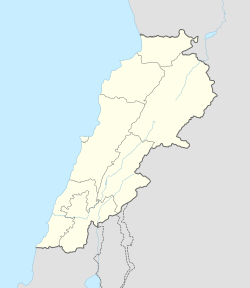Top Qs
Timeline
Chat
Perspective
Maaroub
Municipality in South Governorate, Lebanon From Wikipedia, the free encyclopedia
Remove ads
Maaroub (Arabic: معروب), is a municipality in the Tyre District of Southern Lebanon's South Governorate.[1][2] It is characterized by a blend of old and new architecture. The town is divided into two parts: the old town, and the modern one that has recently arisen.[3]
Remove ads
Etymology
According to E. H. Palmer, the name Marub comes from abounding in water.[4] It has been suggested that the name Maaroub means a "land of great abundance and goodness." It has been also suggested that it means that it is perfect land for agriculture where the agriculture of olive, tobacco, wheat and figs flourish.[5]
Location
Maaroub is located in the South Governorate, Tyre District. It is 270 m above sea level and 88 kilometres to the south-west of Beirut, the capital city of Lebanon, or about an hour and a half, and 15 km from the center of its district Tyre. Its land area is 562 hectares.[6] The number of its registered residents is 3600.[7]
History
Summarize
Perspective
Maaroub is known for its historical monuments, one of those being Cave of Al-Saliha. The Cave of Al-Saliha is located in the middle of the village; specifically, in the old village. The aforementioned cave has the following story, according to local folklore: A pious woman had a shrine she would frequent. Whenever she (mysteriously) appeared; a very beautiful scent would emanate. Thus, it is said that people would visit that place to light candles and pray. This cave dates back at least to Ottoman times.[8]
In 1875, Victor Guérin noted it as "a small village called Ain Ma'roub. It owes its existence to a nearby spring, which flows into the wadi itself and waters fig and pomegranate trees. The population of this village can be estimated at a hundred Metualis. It succeeded an ancient locality; for I see here and there several ashlars and a small Corinthian capital in white marble embedded in the wall of a private house, which, I was told, were found on the spot."[9]
In 1881, the PEF's Survey of Western Palestine (SWP) described it as: "Mud and stone village, containing about 200 Metawileh, built on the side of a hill, with figs and arable land around. Water from cisterns and a spring."[10]
Building
Maaroub was once home to a collection of old houses constructed using traditional methods that markedly differ from contemporary building practices. The conventional technique involved the application of a mixture known as "Madlakeh", consisting of dirt and mud shaped into stones.
Demographics
In 2014 Muslims made up 99.84% of registered voters in Maaroub. 98.54% of the voters were Shiite Muslims.[11]
Notable people
- Ahmad Chhadeh; a Lebanese music produce and founder and CEO of Arabsong Production
- Salah Ezzedine, Lebanese businessman arrested for running a pyramid scheme
- Muhammad Fneish; a Shia Lebanese politician and member of Hezbollah.
- Hussein Fneish (Arabic: حسين فنيش) (October 14, 1993-) is a Lebanese actor. He was born in Maaroub Tyre District.[12] He participated in commercial advertisements, then moved to acting in 2016, where he participated in many works.[13]
Remove ads
References
Bibliography
External links
Wikiwand - on
Seamless Wikipedia browsing. On steroids.
Remove ads
